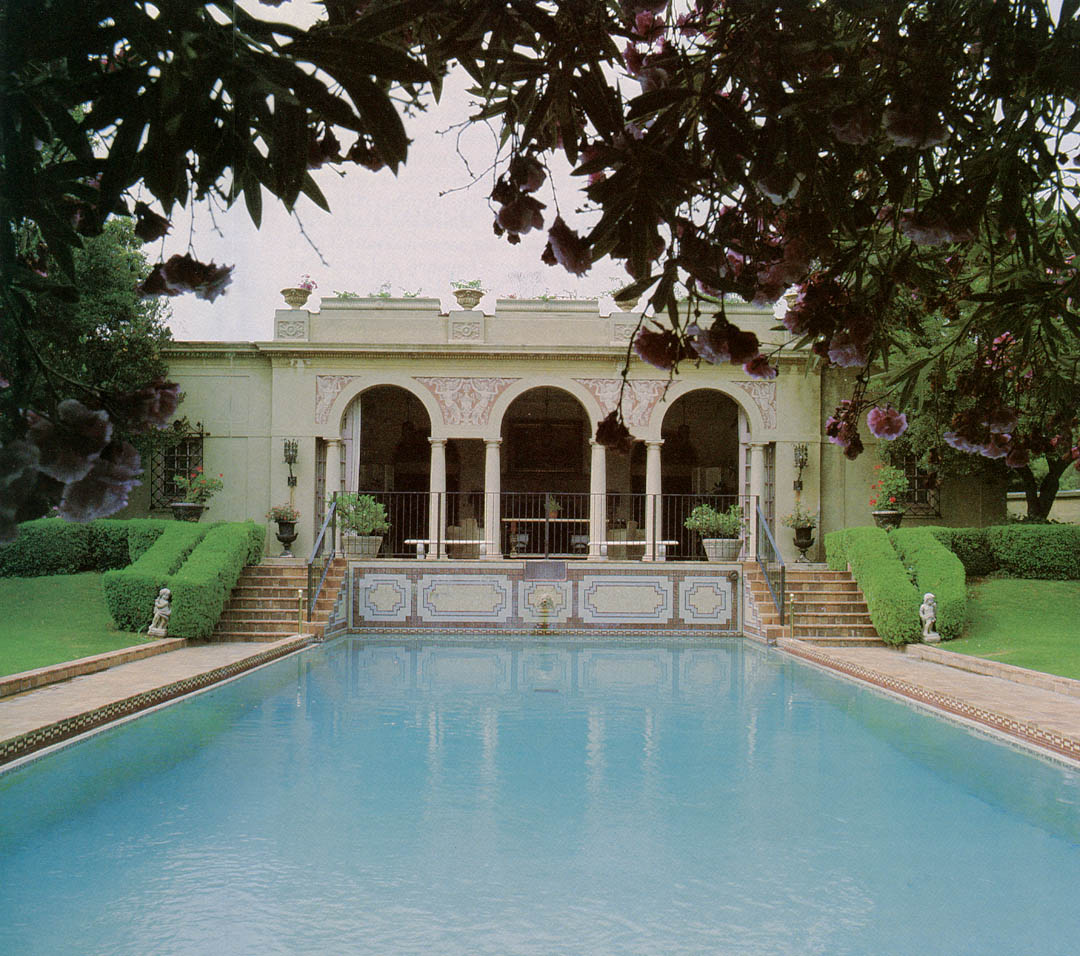

Contributor
- Topics: Archive, Inspired Gardens and Design

Mr and Mrs Harry Robinson came to Beverly Hills in 1908 and built a house at 1008 Elden Way “when there was only a little bit of a real estate office, kind of a shed on Santa Monica Boulevard”* surrounded by fields of barley. He devoted himself to enlarging the fortune from the store founded by his father, J.W. Robinson, while she built a reputation as a socialite, became a doyenne among the well-to-do, and cultivated her interest in gardening. “I’ve had money and that’s nice,” she told a reporter in 1974. “Maybe things would have been different if I’d worked. I never knew a woman who did.”
Almost ten years ago Virginia Robinson deeded the house and six acres to Los Angeles County with an endowment of a million dollars for their upkeep. She stipulated that the grounds be used as a botanic garden, and it thus joins the Los Angeles State and County Arboretum, Descanso Gardens, and the South Coast Botanic Garden under the direction of Francis Ching of the Department of Arboreta and Botanic Gardens. The County assumed ownership upon Mrs Robinson’s death in 1977, but much needed to be done to make the property suitable for public access, even on the limited scale now possible. Last year the garden opened for the first time; it may be visited by appointment.
The climate in this part of Beverly Hills is milder even than that of most of Los Angeles, and Francis Ching sees opportunities for introducing plants that might be more difficult to establish in his other gardens. Experiments are needed, he says, to find pest-resistant plants and those tolerant of polluted air and lower levels of irrigation. New introductions from the tropics and elsewhere will first be grown in the Robinson garden, where they have a better chance of surviving during the difficult period of adapting to southern California’s climate and soil.

The garden already has many unusual specimens and plants. There is, for example, a fine collection of palms, many remarkably large. Kentias (Howeia forsteriana), known to most only as pot plants, here form great groves. King palms (Archontophoenix cunninghamia), some forty feet high, are quite at home, their seeds germinating freely in the soil beneath. There are also many Washingtonias, chamaedoreas, arecastrums, and others, shade from which encourages ferns to cover the ground. Clivias, also lovers of shade, light up dark places with their rich yellow-pink flowers in spring.
The site is a hilltop providing both sunny and shady areas. The palms are on the shady side and the slope is cut into a series of terraces and patios. Some are large and open, offering grand views of the garden below; others are enclosed and whispered conversation seems necessary. One is perfumed with lemon blossoms and gardenias, another lulls with the sound of water. Gratification of senses other than sight, so often neglected in the gardens of others, is studied here.
On the sunny slope flowering trees and shrubs contribute an atmosphere more festive than is found among the palms. Here are the coral trees (Erythrina humeana, E. caffra, and E. cristagalli), whose beak-like flowers are held aloft in vivid red clusters. There are also fine specimens of Montezuma cypress (Taxodium mucronatum) with its lacy foliage, and of Ficus macrophylla, with many sturdy aerial roots.

In 1924 a guest house was built across the lawn from the original house. It is sometimes called the Roman pavilion because of its Palladian columns and arched windows. Together with the tiled terrace and pool, the guest house is more striking than the house completed in 1911. It provided not only accommodations for guests, but also rooms for billiards and cards. Here Mrs Robinson retired for bridge with Fred Astaire and other guests, many well-known beyond Los Angeles; Mae West signed the guest book, and Anthony Eden is said to have been a favorite of Mrs Robinson’s. The lawn was the setting for her annual gala in aid of the Hollywood Bowl and other charity events. The pool is screened from house and lawn by tree-like specimens of double-flowered oleander; rose beds abut the steps and bougainvillea hangs from the walls. Here, shielded from the workaday world, Mrs Robinson lived into her ninety-ninth year, regretting nothing, it is said, and scorning those who “spend their lives just wanting more and more.” What more, we wonder as we leave, could one possibly want?
[sidebar]
*Quotations are from Los Angeles Herald Examiner, June 9, 1974.
[/sidebar]
The garden is open for guided walking tours Tuesday through Friday by appointment only. For reservations call the Los Angeles State and County Arboretum at (213) 446-8251. There is no admittance without advance reservation.








Responses